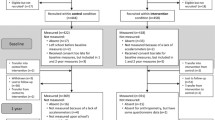Abstract
Children’s play is characterized as pleasurable, but it is also viewed as critical for child health and well-being. Yet over the past decade, play researchers and advocates from various disciplines have suggested that there are decreasing opportunities for children to play, particularly at school. One concern is that the changing play environment in schools is reducing children’s active play options and is thereby contributing to increases in childhood obesity. Building on findings from the Québec Adipose and Lifestyle InvesTigation in Youth (QUALITY), this commentary suggests that while opportunities to engage in physical activity may indeed be differentially shaped by school play environments, physical health may not be the only factor at stake in unequal play environments in schools. While this is not an altogether new concern, we argue that it is nevertheless important to highlight within physical activity research settings that children’s overall well-being, including their experience of pleasure, creativity, imagination and sociability, is also shaped by a school’s play environment. Addressing possible inequalities in children’s experience of play in schools, we propose several questions and future research directions for addressing children’s health and well-being in the school environment.
Résumé
Le jeu des enfants est caractérisé comme étant non seulement plaisant, mais essentiel à leur santé et à leur bien-être. Pourtant, depuis une dizaine d’années, les chercheurs et les défenseurs du jeu dans diverses disciplines indiquent que les enfants ont de moins en moins d’occasions de jouer, particulièrement à l’école. L’un des problèmes est que l’environnement de jeu dans les écoles réduit les options de jeu actif pour les enfants et contribue donc aux augmentations de l’obésité juvénile. Inspiré des constatations de l’enquête QUébec Adipose and Lifestyle Investigation in Youth (QUALITY), notre commentaire suggère qu’il est vrai que les occasions de faire de l’activité physique peuvent varier selon les environnements de jeu des écoles, mais que ces inégalités ne touchent pas uniquement la santé physique. Le problème n’est pas entièrement nouveau, mais nous faisons valoir qu’il est néanmoins important de souligner, dans les milieux de recherche sur l’activité physique, que le bien-être global des enfants, y compris leur expérience du plaisir, de la créativité, de l’imagination et de la sociabilité, se construit aussi par l’environnement de jeu de leur école. Étant donné les inégalités possibles dans l’expérience de jeu des enfants à l’école, nous proposons plusieurs questions et pistes de recherche futures pour aborder la santé et le bien-être des enfants en milieu scolaire.
Similar content being viewed by others
References
Sutton-Smith B. The Ambiguity of Play. Boston, MA: Harvard University Press, 1997.
Gill T. Nothing Ventured: Balancing Risks and Benefits in the Outdoors. Nottingham, England: English Outdoor Council, 2010.
de Jong E, Visscher TLS, HiraSing RA, Heymans MW, Seidell JC, Renders CM. Association between TV viewing, computer use and overweight, determinants and competing activities of screen time in 4- to 13-year-old children. Int J Obes 2013;37:47–53. doi: 10.1038/ijo.2011.244.
Miller E, Almon J. Crisis in the Kindergarten: Why Children Need to Play in School. College Park, MD: Alliance for Childhood, 2009.
McNamara L. What’s getting in the way of play? An analysis of the contextual factors that hinder recess in elementary schools. Can J Action Res 2013;14:3–21.
Active Healthy Kids Canada. Is Active Play Extinct? Report Card on Physical Activity for Children and Youth. Toronto, ON: Active Healthy Kids Canada, 2012.
Black IE, Menzel NN, Bungum TJ. The relationship among playground areas and physical activity levels in children. J Pediatr Health Care 2015;29:156–68. PMID: 25454386. doi: 10.1016/j.pedhc.2014.10.001.
Howe CA, Freedson PS, Alhassan S, Feldman HA, Osganian SK. A recess intervention to promote moderate-to-vigorous physical activity. Pediatr Obes 2012;7:82–88. PMID: 22434742. doi: 10.1111/j.2047-6310.2011.00007.x.
Lambert M, Van Hulst A, O’Loughlin J, Tremblay A, Barnett TA, Charron H, et al. Cohort profile: The Quebec adipose and lifestyle investigation in youth cohort. Int J Epidemiol 2012;41(6):1533–44. PMID: 21785124. doi: 10.1093/ije/dyr111.
Lynch M. More play, please: The perspective of kindergarten teachers on play in the classroom. Am J Play 2015;7:347–70.
McNamara L, Colley P, Franklin N. School recess, social connectedness and health: A Canadian perspective. Health Promot Int 2015;pii:dav102. PMID: 26497586. doi: 10.1093/heapro/dav102.
Ramstetter CL, Murray R, Garner AS. The crucial role of recess in schools. J Sch Health 2010;80:517–26. PMID: 21039550. doi: 10.1111/j.1746-1561.2010.00537.x.
Sattelmair J, Ratey JJ. Physically active play and cognition: An academic matter? Am J Play 2009;1(3):365–74.
Krahnstoever Davison K, Lawson CT. Do attributes in the physical environment influence children’s physical activity? A review of the literature. Int J Behav Nutr Phys Act 2006;3:19. doi: 10.1186/1479-5868-3-19.
Ridgers ND, Salmon J, Parrish A-M, Stanley RM, Okely AD. Physical activity during school recess: A systematic review. Am J Prev Med 2012;43(3):320–28. doi: 10.1016/j.amepre.2012.05.019.
Roskos KA, Christie JF (Eds.). Play and Literacy in Early Childhood: Research from Multiple Perspectives. NJ: Routledge, 2009.
Alexander SA, Frohlich KL, Fusco C. Problematizing “play for health” discourses through children’s photo-elicited narratives. Qual Health Res 2014;24:1329–41. PMID: 25147214. doi: 10.1177/1049732314546753.
Van Hulst A, Barnett TA, Gauvin L, Daniel M, Kestens Y, Bird M, et al. Associations between children’s diets and features of their residential and school neighbourhood food environments. Can J Public Health 2012; 103: S48–54.
Active Healthy Kids Canada. Is Canada in the Running? How Canada Stacks up Against 14 Other Countries on Physical Activity for Children and Youth. Toronto, ON: Active Healthy Kids Canada, 2014.
Canadian Fitness and Lifestyle Research Institute. Bulletin 1: Availability of larger scale facilities supporting physical activity and sport. Ottawa, ON: CFLRI, 2012. Available at: http://www.cflri.ca/document/bulletin-01-availability-larger-scale-facilities-supporting-physical-activity-and-sport (Accessed March 15, 2015).
UNICEF. The State of the World’s Children 2012: Children in an Urban World. New York, NY: United Nations Children’s Fund, 2012.
Author information
Authors and Affiliations
Corresponding author
Additional information
Conflict of Interest: None to declare.
Rights and permissions
About this article
Cite this article
Alexander, S.A., Barnett, T.A. & Fitzpatrick, C. Are inequalities produced through the differential access to play opportunities at school? A call to level the playing field. Can J Public Health 107, e583–e585 (2016). https://doi.org/10.17269/CJPH.107.5471
Received:
Accepted:
Published:
Issue Date:
DOI: https://doi.org/10.17269/CJPH.107.5471




